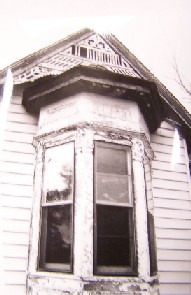A Quick Patch, Part 2
Here is Part Two.
I found a piece of scrap wood that was about 3/4" thick and 1 3/4 wide and cut a length that would span the hole plus 2-3" to each side of the hole. The total length was about 6-7 inches.
I drove two screws into the wall, one on each side of the hole. Since I don't have a counter-sink bits for my drill, I sank the screw in as far as they would go and then removed them. I used a knife to deepen the holes the screw heads had made. Then, I sank the screws in until their tips had just cleared the back side of the wallboards.
I took the stub of wood and partly sunk a screw in the middle of it. This would serve as my "handle" so I could insert it into the hole and hold it flush with the back of the wallboards. Once it was in place, I sank the two screws in all the way. Here is a picture.
 I then removed the central screw and inserted the patch I'd cut in part 1. It fit pretty well, so I sank one screw into the center of it using the same method as above. Then, I shot several 1 1/8 brads into it to help hold it in place.
I then removed the central screw and inserted the patch I'd cut in part 1. It fit pretty well, so I sank one screw into the center of it using the same method as above. Then, I shot several 1 1/8 brads into it to help hold it in place.
Now that the patch was secure, I caulked it. After the fact, it occurred to me that I could have also used wood putty or epoxy for this as well. Both would have produced a smoother finish, but, with walls this rough, it would be more effort than it's worth.
 Here is the patch after a single coat of paint. Not bad minus the fact that it could use 3-4 more coats.
Here is the patch after a single coat of paint. Not bad minus the fact that it could use 3-4 more coats.

I've put on three more coats since this picture was taken. I'll have a picture of the finished product in Part 3 and a review of the EZ Clean Paint Brush (about 7 months after the fact).
I found a piece of scrap wood that was about 3/4" thick and 1 3/4 wide and cut a length that would span the hole plus 2-3" to each side of the hole. The total length was about 6-7 inches.
I drove two screws into the wall, one on each side of the hole. Since I don't have a counter-sink bits for my drill, I sank the screw in as far as they would go and then removed them. I used a knife to deepen the holes the screw heads had made. Then, I sank the screws in until their tips had just cleared the back side of the wallboards.
I took the stub of wood and partly sunk a screw in the middle of it. This would serve as my "handle" so I could insert it into the hole and hold it flush with the back of the wallboards. Once it was in place, I sank the two screws in all the way. Here is a picture.
 I then removed the central screw and inserted the patch I'd cut in part 1. It fit pretty well, so I sank one screw into the center of it using the same method as above. Then, I shot several 1 1/8 brads into it to help hold it in place.
I then removed the central screw and inserted the patch I'd cut in part 1. It fit pretty well, so I sank one screw into the center of it using the same method as above. Then, I shot several 1 1/8 brads into it to help hold it in place.Now that the patch was secure, I caulked it. After the fact, it occurred to me that I could have also used wood putty or epoxy for this as well. Both would have produced a smoother finish, but, with walls this rough, it would be more effort than it's worth.
 Here is the patch after a single coat of paint. Not bad minus the fact that it could use 3-4 more coats.
Here is the patch after a single coat of paint. Not bad minus the fact that it could use 3-4 more coats.
I've put on three more coats since this picture was taken. I'll have a picture of the finished product in Part 3 and a review of the EZ Clean Paint Brush (about 7 months after the fact).
Labels: living room, progress



0 Comments:
Post a Comment
<< Home